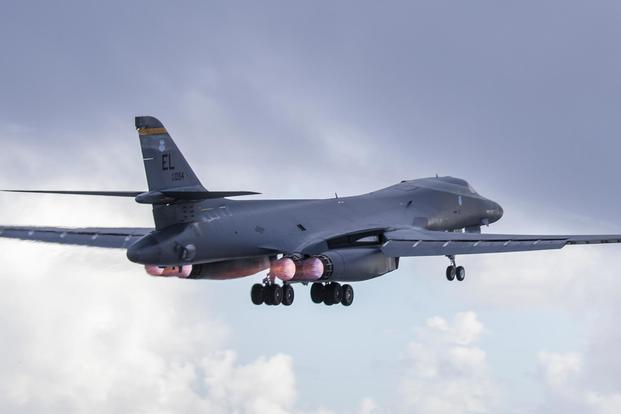Some B-1B Lancer bombers have returned to flight operations after officials grounded the fleet last month over a fuel system issue.
The first aircraft resumed operations this week, Air Force Global Strike Command said in a news release Thursday. The command did not provide the exact number of Lancers that have returned to their missions following the safety stand-down or how many were affected by the fuel system issue, citing operational security.
"Individual B-1B aircraft will return to flight as inspections and maintenance directed during the stand-down are completed on each aircraft," a spokesman from the command said in an email.
Read Next: Fort Jackson Trainee Arrested After Hijacking a School Bus Full of Children
Gen. Tim Ray, head of Air Force Global Strike Command, grounded the fleet April 20 for inspections on the fuel filter housing. The issue was discovered when a B-1 began leaking fuel after landing at Ellsworth Air Force Base, South Dakota, on April 8. Maintainers found a problem in its Augmenter Fuel Pump Filter Housing.
Over the last several weeks, maintenance and depot personnel disassembled the housings in each aircraft to check for leaks and defects, the command said in the release. Once a system was determined to be free of defects, it was reassembled and pressure checked before the aircraft returned to service.
"We are proud of the tremendous efforts of our maintainers and B-1 partners in identifying, inspecting and remediating any potential issues with the B-1B fuel filter housing," Maj. Gen. Mark Weatherington, 8th Air Force commander, who oversees the Air Force bomber force, said in the release. "The aircraft are still safe to fly, and we are confident that this stand-down has resulted in increased safety within the B-1B fleet."
The collaborative effort spanned both B-1 bomber bases, Ellsworth and Dyess Air Force Base, Texas, and included support from personnel at the Air Force Sustainment Center at Tinker Air Force Base, Oklahoma, and the Air Force Life Cycle Management Center at Wright-Patterson Air Force Base, Ohio.
The stand-down -- the fleet's third in three years -- comes as the Air Force is working to retire some of its B-1s, reducing the active fleet to 45 aircraft to better sustain the most functional planes.
Congress authorized 17 bombers to be divested, used for test purposes or sent to a museum. The Air Force has said it anticipates retiring those aircraft by the end of September.
Due to heavy use in the Middle East over a decade as the only U.S. supersonic heavy-payload bomber, the B-1 fleet saw repeated breakdowns and required extensive maintenance as frequent deployments caused the aircraft to deteriorate more quickly than expected, Ray said in 2019.
By the end of March that year, Ray had ordered a stand-down, marking the second fleetwide pause in about a year, after a rigged "drogue chute" was incorrectly installed in an ejection seat egress system. The bombers underwent a careful inspection process and slowly returned to flight lines starting that April.
The command had grounded the fleet the year before over another problem related to the Lancer's ejection seats. That stand-down lasted three weeks while the fleet was inspected.
The service plans to retire the entire fleet by 2036.
-- Oriana Pawlyk can be reached at oriana.pawlyk@military.com. Follow her on Twitter at @oriana0214.
Related: B-1 Bomber Fleet Grounded Indefinitely Over Fuel System Problem













